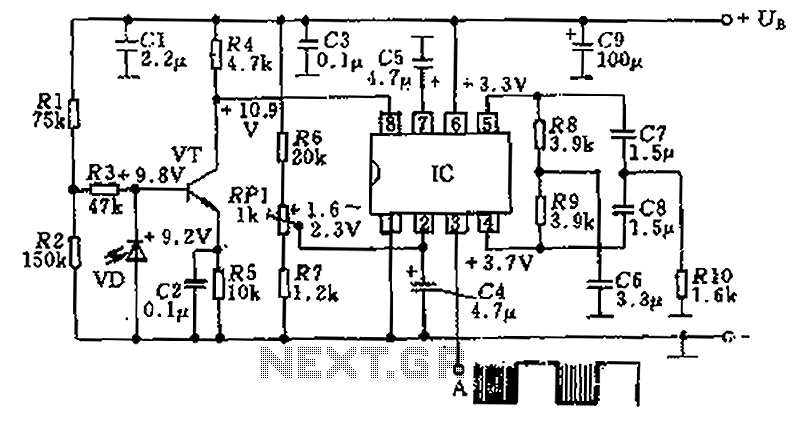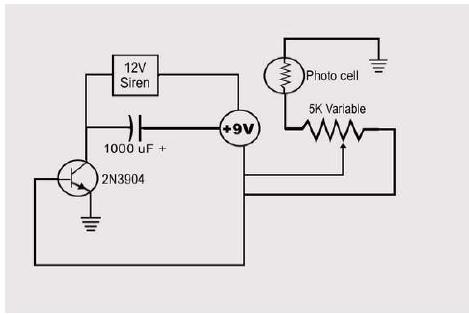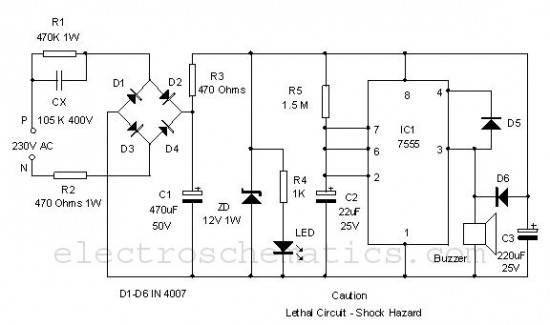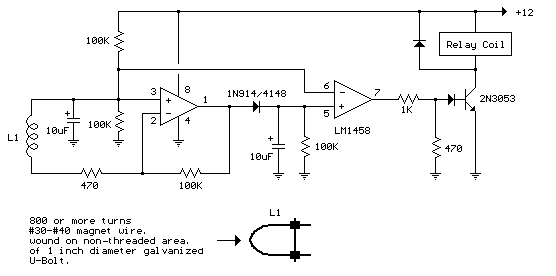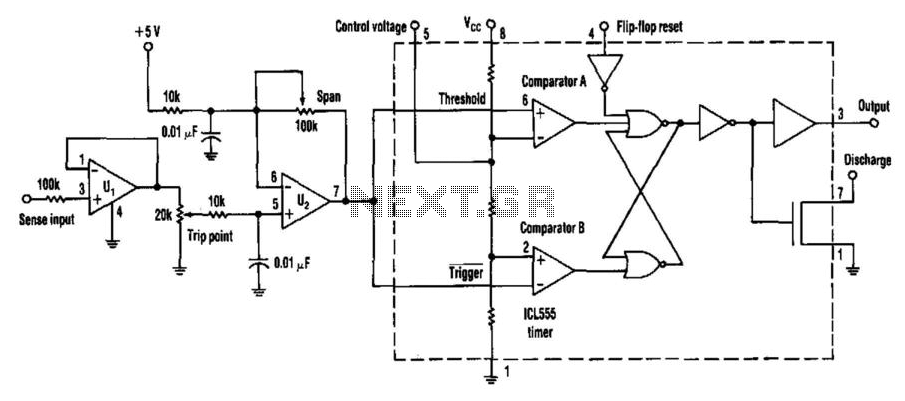
LM1801 smoke detector circuit design electronic project
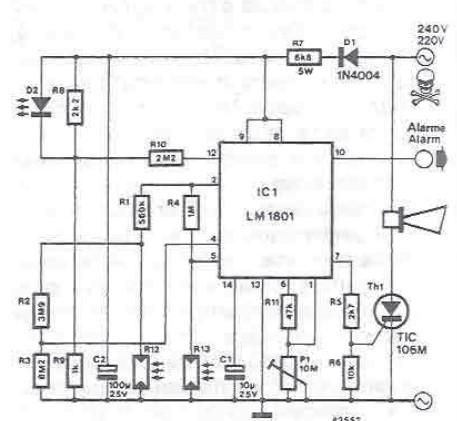
This smoke detector electronic project is designed using the LM1801 and common electronic components. The smoke detector circuit diagram does not utilize ionization detection, gas sensors, or optocouplers; instead, it employs two photoresistors (LDRs) and an LED. The circuit incorporates a pair of phototransistors for compensation, which mitigates any resistance variations caused by temperature changes or aging effects. The circuit consists of a network bridge with resistors R1 and R4, along with two LDRs (R12 and R13) connected to one of the comparator input common points of R4 and R13. The other comparator inputs are linked internally to the junction of R1 and R2 voltage divider R12 and R3. This configuration ensures that both LDRs are polarized to the same voltage for accurate tracking. The LDRs should be positioned to allow smoke particles to reflect light from the LED (D2) in R3, thereby reducing their resistance. When the comparator detects this voltage drop, the integrated circuit activates the Th1 triac (SCR), which powers the siren, putting it into operation. Circuit sensitivity can be adjusted using P1, and the LED D2 should be mounted equidistantly between the two photoresistors.
This smoke detector circuit operates on a principle of light reflection and resistance measurement. The LM1801 serves as a comparator, processing the voltage levels from the LDRs to determine the presence of smoke. The LDRs are sensitive to changes in light intensity; when smoke particles enter the detection area, they scatter the light emitted by the LED, causing a decrease in the resistance of the LDRs. This change in resistance translates to a voltage drop at the comparator inputs.
The network bridge formed by R1 and R4, along with the voltage divider created by R12 and R3, ensures that both LDRs receive a stable reference voltage. This is crucial for maintaining consistent readings and improving the reliability of the smoke detection mechanism. The adjustment potentiometer P1 allows for fine-tuning of the circuit's sensitivity, enabling the user to set the threshold at which the circuit will trigger an alarm based on environmental conditions or specific requirements.
In practical applications, the positioning of the LDRs and the LED is vital for optimal performance. They should be arranged such that the LED's light can effectively illuminate the area where smoke is likely to be detected, maximizing the likelihood of scattering and subsequent resistance change in the LDRs. The use of a triac (Th1) as a switching element allows for the control of higher power loads, such as a siren or alarm system, ensuring that the smoke detector can effectively alert individuals in the vicinity of detected smoke.
Overall, this smoke detector design is a cost-effective solution that leverages basic electronic components to provide reliable smoke detection without the need for more complex ionization or gas detection methods. The simplicity of the design makes it accessible for DIY enthusiasts and educational projects while maintaining functional efficacy in smoke detection applications.This smoke detector electronic project is designed using LM1801 and common electronic parts. Smoke detector circuit diagram below does not use ionization detection, gas or optocouplers it use two photoresistors (LDR`s) and an LED. The circuit uses a pair phototranzistors for compensation which removes any resistance caused by changes in temperatur
e or aging effects. This circuit is made of network bridge R1, R4, two LDR`s (R12, R13) connected to one of the comparator inputs common point of R4 and R13. The other comparator inputs are connected internally to the point of R1 and R2 voltage divider R12 and / R3.
This arrangement provides both LDR`s polarization to the same voltage, to achieve accurate tracking. Physically, LDR s should be located so that smoke particles reflect light from the LED (D2) in R3, leading to lower its resistance. Once comparator detects this voltage drop, the integrated circuit commands Th1 triac (SCR) powering siren putting it into operating mode.
Circuit sensitivity is adjusted with P1, the LED D2 should be mounted between the two photoresistors at approximately equal distances. 🔗 External reference
This smoke detector circuit operates on a principle of light reflection and resistance measurement. The LM1801 serves as a comparator, processing the voltage levels from the LDRs to determine the presence of smoke. The LDRs are sensitive to changes in light intensity; when smoke particles enter the detection area, they scatter the light emitted by the LED, causing a decrease in the resistance of the LDRs. This change in resistance translates to a voltage drop at the comparator inputs.
The network bridge formed by R1 and R4, along with the voltage divider created by R12 and R3, ensures that both LDRs receive a stable reference voltage. This is crucial for maintaining consistent readings and improving the reliability of the smoke detection mechanism. The adjustment potentiometer P1 allows for fine-tuning of the circuit's sensitivity, enabling the user to set the threshold at which the circuit will trigger an alarm based on environmental conditions or specific requirements.
In practical applications, the positioning of the LDRs and the LED is vital for optimal performance. They should be arranged such that the LED's light can effectively illuminate the area where smoke is likely to be detected, maximizing the likelihood of scattering and subsequent resistance change in the LDRs. The use of a triac (Th1) as a switching element allows for the control of higher power loads, such as a siren or alarm system, ensuring that the smoke detector can effectively alert individuals in the vicinity of detected smoke.
Overall, this smoke detector design is a cost-effective solution that leverages basic electronic components to provide reliable smoke detection without the need for more complex ionization or gas detection methods. The simplicity of the design makes it accessible for DIY enthusiasts and educational projects while maintaining functional efficacy in smoke detection applications.This smoke detector electronic project is designed using LM1801 and common electronic parts. Smoke detector circuit diagram below does not use ionization detection, gas or optocouplers it use two photoresistors (LDR`s) and an LED. The circuit uses a pair phototranzistors for compensation which removes any resistance caused by changes in temperatur
e or aging effects. This circuit is made of network bridge R1, R4, two LDR`s (R12, R13) connected to one of the comparator inputs common point of R4 and R13. The other comparator inputs are connected internally to the point of R1 and R2 voltage divider R12 and / R3.
This arrangement provides both LDR`s polarization to the same voltage, to achieve accurate tracking. Physically, LDR s should be located so that smoke particles reflect light from the LED (D2) in R3, leading to lower its resistance. Once comparator detects this voltage drop, the integrated circuit commands Th1 triac (SCR) powering siren putting it into operating mode.
Circuit sensitivity is adjusted with P1, the LED D2 should be mounted between the two photoresistors at approximately equal distances. 🔗 External reference

